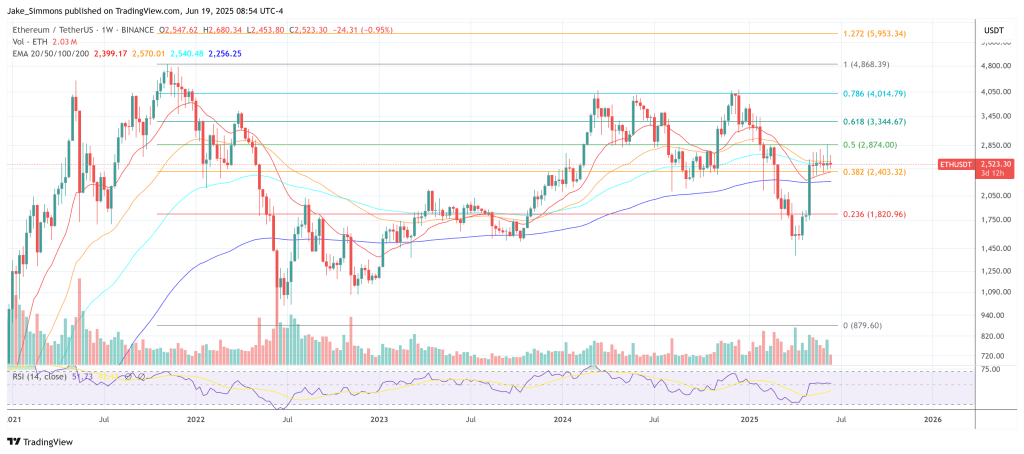Joseph Lubin, the illustrious co-founder of Ethereum and the grand maestro of Consensys, took to the digital stage of X on 19 June to unveil a vision so grand, it might as well have been scripted by a Victorian-era prophet. After bestowing his laurels upon a research note that likened ETH to “digital oil,” Lubin, with a flourish of his rhetorical wand, declared that the author, while commendably insightful, had yet to grasp the full magnitude of Ethereum’s economic destiny.
“This is a very strong piece of work in so many ways,” he began, his words dripping with the honey of praise. “Probably everyone who reads this work will learn something and be stoked by the thesis. But this top-tier thought piece has one major structural flaw—a pretty deep structural flaw: it is not bullish enough.”
Ethereum Could Outscale Global GDP
Lubin’s grand vision is that of a “hybrid human-machine intelligence society” where Ether will serve as the bedrock of value creation, a society whose economic footprint will dwarf the current $113.8 trillion global economy. “It is not a great leap,” he wrote, “to suggest that the value resident on and flowing through Ethereum, which will constitute a large portion of Web3—the re-decentralised—will be orders of magnitude larger than today’s global GDP. Just look at how the energy, chips, and data-centre spend is growing exponentially and how AI is accelerating everything.”
He revisited the age-old Bitcoin-versus-Ethereum debate, where BTC is the “Gold 2.0” and ETH is the native asset of a programmable economy, but he pushed the boundaries further. “While BTC should be valued as Gold 2.0,” Lubin reiterated, “ETH should be valued on the scale of the emergent decentralised global economy.” This new paradigm, he argued, must now be expanded to encompass an AI-driven explosion in digital activity that will “grow largely on decentralised rails.”
Lubin dedicated half of his post to a thought experiment first sketched on 4 June. “If there was a magical trust-diamond commodity and you could apply chips of this diamond to every transaction, agreement, or relationship … how much value would that add? 10% to global GDP? 100%? 1,000%? … The ticker of that commodity is ETH.”
In his view, Ethereum’s uniquely decentralised validator set makes Ether “the highest-grade or gold standard of trust on the planet.” This “trust commodity” premium, combined with the “digital-oil” demand for transaction fees, is what Lubin believes will propel ETH’s fully diluted value far beyond any historical asset benchmark.
Reality Check—Today’s Numbers
For now, the chasm between aspiration and market capitalisation remains vast. Ether’s float of roughly 120 million coins traded at $2,525 on 19 June, giving the network a market value near $307 billion, a mere 0.3% of world output. Yet even this float is shrinking: more than 35 million ETH—about 29% of supply—is now locked in proof-of-stake contracts, an all-time high reached this week.
Lubin, ever the optimist, sees this supply-side tightening as a prelude, not a finale. “Both of these models,” he wrote of the digital-oil and trust-commodity frameworks, “will lead to a giant monetary premium for ETH.”
Whether Ether can plausibly “eclipse” worldwide output—a threshold no single asset has come close to—remains an open question. Lubin’s rhetorical diamond, however, sharpens the stakes: in a future where programmable trust becomes a primary input of production, valuing ETH merely as software gas may prove, to borrow his phrase, “not bullish enough.”
At press time, ETH traded at $2,523.

Read More
- Gold Rate Forecast
- SOL PREDICTION. SOL cryptocurrency
- USD THB PREDICTION
- RENDER PREDICTION. RENDER cryptocurrency
- XRP PREDICTION. XRP cryptocurrency
- USD IDR PREDICTION
- ARB PREDICTION. ARB cryptocurrency
- CNY RUB PREDICTION
- EUR CAD PREDICTION
- GBP CNY PREDICTION
2025-06-20 07:13